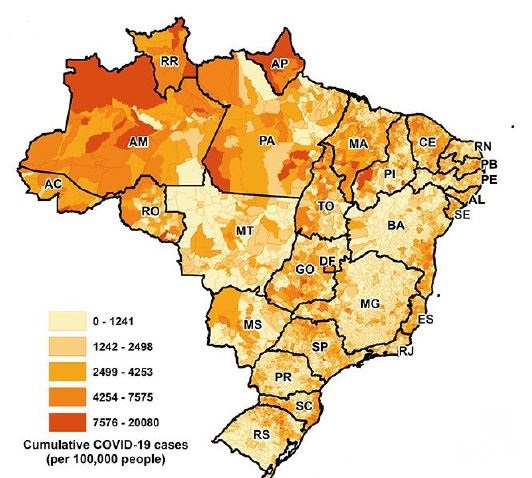Brazil’s COVID-19 crisis has steadily worsened this spring. With only 2.7% of the world’s population, Brazil ranks third globally for the total number of people infected with COVID-19, and it is surpassed only by the US and India. It has the regrettable distinction of ranking second globally for deaths due to COVID-19, at slightly more than 395,000.
Countries where the virus is spreading out of control lead researchers to ask, Why? What factors might explain why the virus infects and kills so many people in one country, but not in others?
Burton Singer, a UF mathematician who focuses on modeling infectious disease dynamics, collaborated with researchers from Brazil and Harvard University’s T.H. Chan School of Public Health to understand the spread of COVID-19 throughout Brazil. Their work was recently published in Science.
“We knew it was erratic and going in different ways,” says Singer, a professor in UF’s College of Liberal Arts and Sciences and a member of UF’s Emerging Pathogens Institute. “And initially we naively thought that there would be a summary narrative that would describe Brazil as a country. But that turned out to be totally false.”
Major findings
By mapping how the virus spread over time throughout the country, the researchers uncovered clues that point to a few noticeable drivers. First, differences were evident between how regional government officials enforced public health measures, or not, from one municipality to the next.
“You can tell just by comparing the spread rates between municipalities if there was masking and social distancing or not,” Singer says. “It spread more slowly in areas with strong measures in place.”

A figure from the paper, courtesy of the authors, depicts the spread of the virus over time and space. Panel A and B show COVID-19 cases (A) and deaths (B) per 100,000 citizens. Panels C and D show the clustering of cases (C) and deaths (D) over time and space. The paper uses data from February to October of 2020 when the virus initially spread.
Second, the country’s river system drove spread due to people’s reliance on riverboats for transportation.
“A lot of people in some areas are really dependent upon riverboats, along tributaries of the Amazon and smaller rivers in Brazil, to go to work,” Singer says. “The people are packed in, the music is great, it’s a terrific scene. But it’s the worst possible thing for COVID transmission.”
While Singer offers it would take a much longer paper, and more detailed data, to trace the effect of crowded river transportation upon spread rates, he says the new data analysis hints that riverboats likely played a role in certain areas.
Third, high-density living in large cities, particularly within favelas, make it impossible for people to maintain social distance from one another. This fueled rapid spread even in places where government officials were supportive of public health measures to mitigate infection rates, Singer says.
Other findings
In most instances, the team found that documented infections would begin within the primary city of a municipality. (Brazilian municipalities are equivalent to US counties.) From there, spread of the virus would radiate.
“There was almost always spread going great distances from the cities,” Singer says. “This is due to people traveling without protective measures and spreading COVID as they go.”
This has strong implications for global travel, Singer says, as air travel in and out of the country could potentially export Brazil’s COVID problem to other countries.
But one of the most surprising findings was that deaths peaked before documented infections in some areas.
“We found that initially, the people who were infected were among the most vulnerable, in some areas,” Singer says. “We were surprised to see the deaths peaked first in some municipalities. It’s astounding.”
While some may argue that perhaps the earliest infections were missed, Singer opines this is unlikely.
“Brazil has a fantastic national data system that made our analysis possible,” Singer says. “But I suspect there is little difference between what you see in Brazil and what’s happening here in the US. They are just documenting it better.”
This story originally appeared on UF Emerging Pathogens Institute.
Check out stories about UF research on COVID-19.

